Table of Contents
CTC CMS for Autodesk AutoCAD, Civil 3D and Revit
The CMS application, when installed, includes plugins for AutoCAD based platforms and addins for Revit.
The general usage guide for CMS can be found here: Getting Started with CMS for Windows. It is recommended to start with the basics before moving on to the specific functionalities of the plugin and addin.
Using CMS with Civil 3D and AutoCAD
The CMS application will recognize AutoCAD whenever it detects it running and there is a dwg open. Once it has found an AutoCAD session, it will display the name of it below the top toolbar as a selection in the “Design app:” list.

If more than one instance or version of AutoCAD is running, use the drop list to switch between them. The version and active document name are used to identify them.

If more than one drawing is open, switch between them in AutoCAD and the Design app selection will update automatically.
Notes About Working with Multiple AutoCAD Instances
- Whenever an instance of AutoCAD is opened or closed, the CMS application may take a few seconds to update the list.
- If an instance of AutoCAD does not show up as expected, click the refresh button next to the Design app menu. If it still does not show up as expected, it may be an unsupported version.
- If AutoCAD has a command active in the session window, the CMS application may not interrupt it. In these cases, it is necessary to end the command first.
Occasionally, it may be necessary to end a command in between loading content. Especially on double-click loads as these default to a placement action.
Viewing Content Details (AutoCAD Content)
The CMS extracts and stores data about AutoCAD content that can be viewed in the application such as:
- Category
- Units
- AutoCAD Version
- General Properties
- Insertion Values
To view the details of AutoCAD content, open the “Details” pane. This can be done via the right-click context menu on the content item (1).
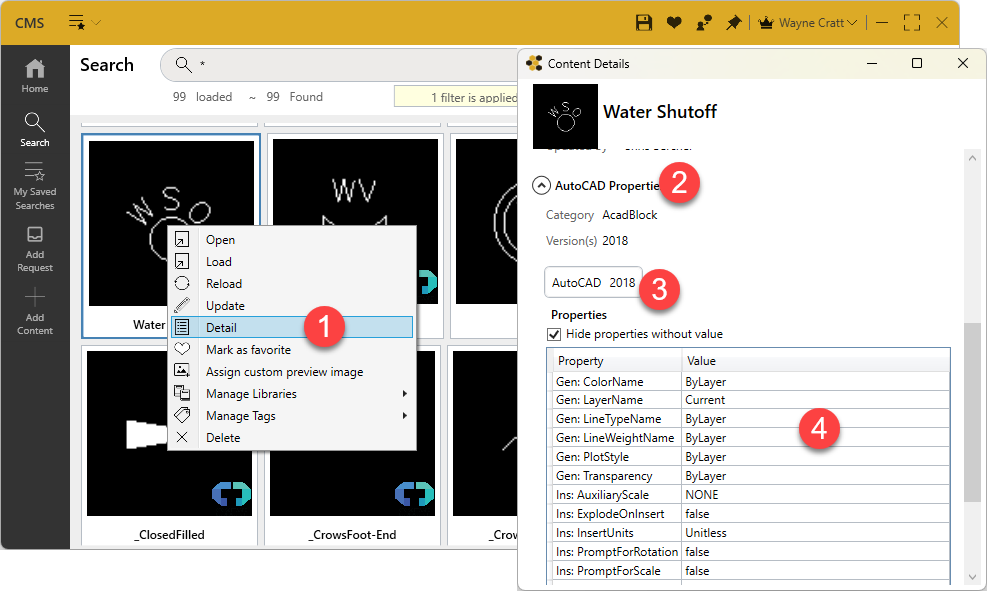
AutoCAD properties (2) are listed below the content details. Click to expand.
The AutoCAD versions that this content is available for are listed (3). The application will use the closest match available when loading the content for the selected AutoCAD version.
For AcadBlock(s), the properties and values table (4) is shown.
By default, properties with no values are hidden to simplify viewing. Uncheck this to see all properties.
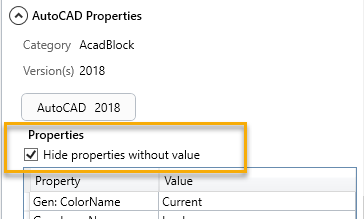
Loading Content into AutoCAD
There are various ways of using content in AutoCAD.
Double-click - Load:
Typically, the fastest way to load into a drawing is by this method.
Right-click Load/reload:
If the block is not already loaded, it will load for the first time. If reload is chosen, it will be reloaded, updating the block(s) in the drawing.
Both commands will then prompt for placement in the model.
Right-click – Load Multiple:
Select multiple content items by holding down the CTRL or SHIFT keys while left-clicking on several items. A right-click → load or reload action will then bring all of the selected items into the current drawing.
At the end of the operation, a list of errors, if there are any, will be presented. If not, the blocks will load with prompting for placement.
Other AutoCAD Content Types
- AutoCAD template files (.dwt) when loaded will start a new drawing.
- AutoCAD sheet set files (.dst) will create a sheet set.
Using AutoCAD Scripts
This image shows the content category as AcadLisp for LISP or .SCR files.

Scripts such as LISP can be added and managed in the CMS. This extremely useful feature enables users to load commands without needing to do it via the command line.
AutoCAD protects the user from inadvertently loading scripts that may be harmful by warning them of the load. When loading a script from the CMS, the user will receive a message.
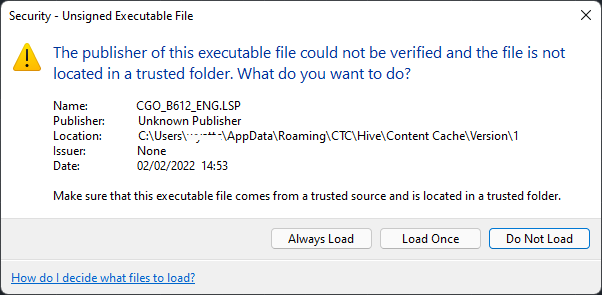
The loading of scripts warning can be controlled by administrators in the CMS portal Organization Settings.
Using CMS with Autodesk ® Revit
The CMS application will recognize Revit whenever it detects it running. Once it has found a Revit session, it will display the name of it below the top toolbar.
If more than one instance, model or version of Revit is running, use the drop list to switch between them. The version, active document name and view are used to identify them.

Notes About Working with Multiple Revit Instances
- Whenever an instance of Revit is opened or closed, the CMS application may take a few seconds to update the list.
- If an instance of Revit does not show up as expected, click the refresh button next to the menu. If it still does not show up as expected, it may be an unsupported version.
- Some categories of families cannot be loaded in certain views (for example: a furniture family cannot be placed in a schedule view).
- If Revit has a command active in the session window, the CMS application will not interrupt it. In these cases, it is necessary to end the command in Revit. Click to activate the view, press the ESC key twice or click the “Modify” tool button on the Revit tool ribbon.

Occasionally, it may be necessary to perform the above action in between loading content. Especially on double-click loads as these default to a placement action.
Viewing Content Details (Revit Content)
CMS extracts and stores data about Revit content that can be viewed in the application such as:
- Category
- Units
- Revit Version
- Types (for families)
- Parameter Values
To view the details of Revit content, open the “Details” pane. This can be done via the right-click context menu on the content item (1).
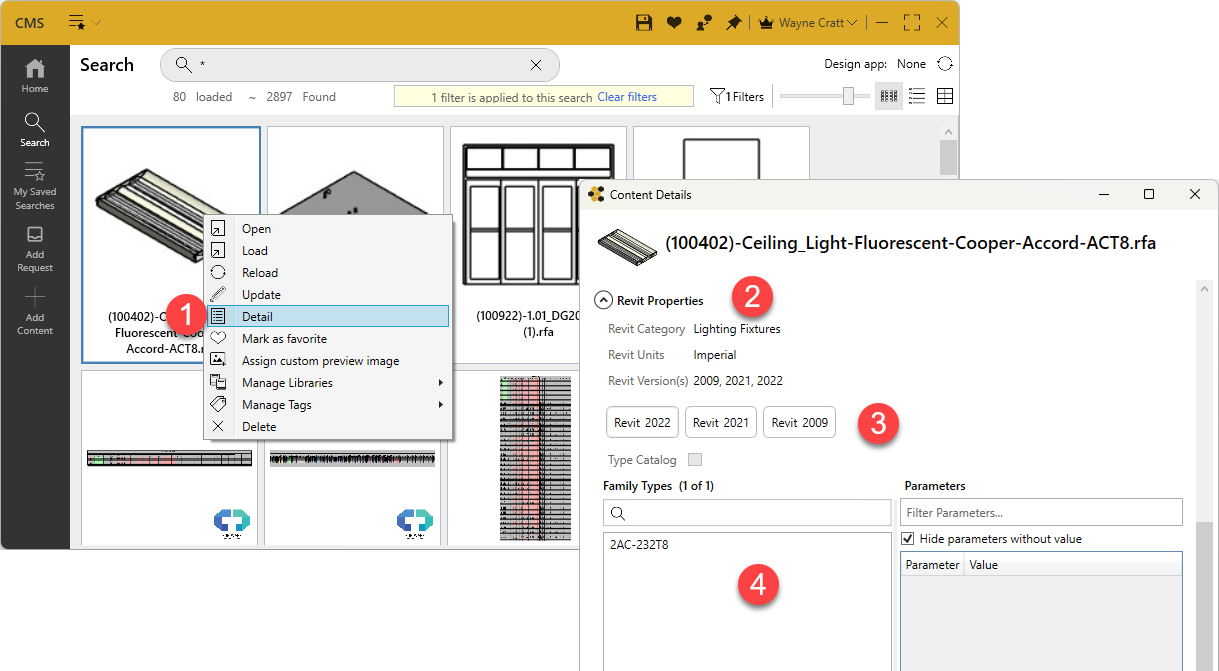
Revit properties (2) are listed below the content properties. Click to expand.
The Revit versions that this content is available for are listed (3). The application will use the closest match available when loading the content for the selected Revit version.
For families, the types and parameters tables (4) are shown here. To see the parameter values for each type, select one from the list on the left.
Enter terms in the type list search box to filter the list.
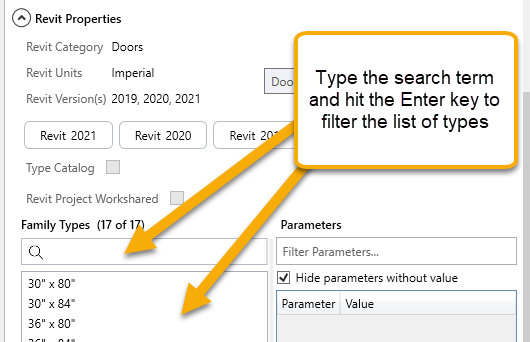
By default, parameters with no values are hidden to simplify viewing. Uncheck this to see all parameters for each type.

Loading Content into Revit
There are various ways of using content in Revit.
The Load Button:
When hovering over an item in the search results, a round “Load” icon will appear. Click this to start the content loading.
Double-click - Load:
Typically, the fastest way to load a family into a model is by this method. If the CMS app setting “Display type selector dialog” is enabled, it will be shown prior to starting the placement command.
This dialog allows for the selection of one or more types to be loaded into the model.
Right-click Load/reload:
If the family is not already loaded, it will load for the first time. If reload is chosen, it will be reloaded, updating the family in the model.
Both commands will then prompt for placement in the model.
Right-click – Load Multiple:
Select multiple content items by holding down the CTRL or SHIFT keys while left-clicking on several items. A right-click → load or reload action will then bring all of the selected items and each family’s types into the model.
At the end of the operation, a list of errors, if there are any, will be presented. If not, the families will load with prompting for placement.
Content Loaded Indication
If a piece of content visible in search results has previously been loaded into the current Revit project model from CMS, the content will be highlighted pale-blue.
If a piece of content has been updated more recently than what was loaded into the model from CMS, it will highlight pale-orange. Simply use the 'load' feature to update the version in the model.
The Type Selector
Family Types: Internal
When loading a family, the type selector will display the best match version available. This can be set as desired.
Select a type or more to load with the family.
Skip the selections if all types should be loaded.
Type selector has a search function for long lists of types.
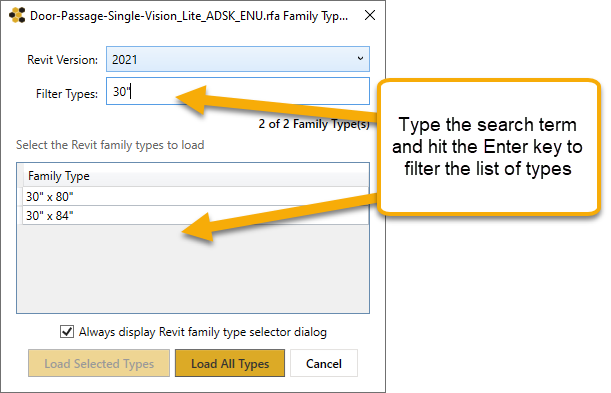
Once loaded, Revit will prompt for placement. Use the properties panel in Revit to select the type to place.

If more types are needed, simply load them from the CMS application and they will be added to the family types currently in the model.
If the family in the model has additional types that did not come from the version in CMS, they will remain in the model only.
Family Types: Type Catalogs
Revit families with type catalogs can be used in much the same way as standard types.
Families with type catalogs are indicated with a checked “Type Catalog” label.
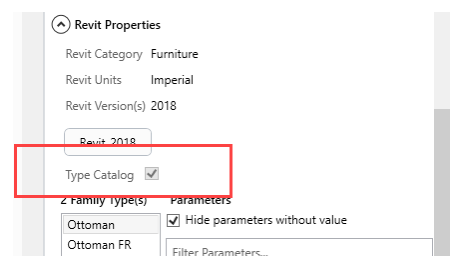
Double-click or use the context menu to download the family and choose the type(s).
Select types for placement using the Revit type selector.
The Drafting View Selector
When loading a sheet of drafting views from the CMS, a view selector will appear that allows the loading of only some or all of the views contained on the sheet.